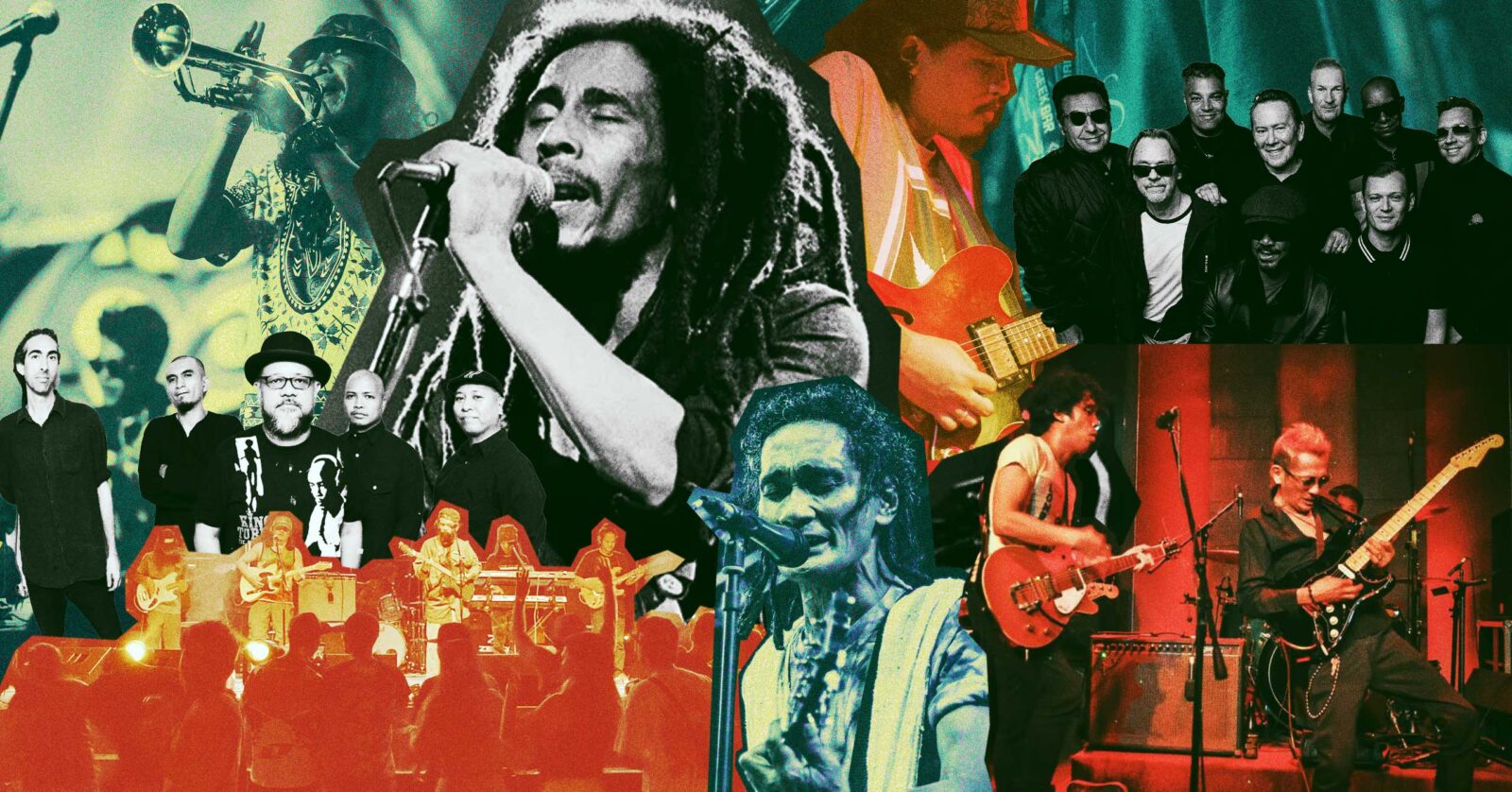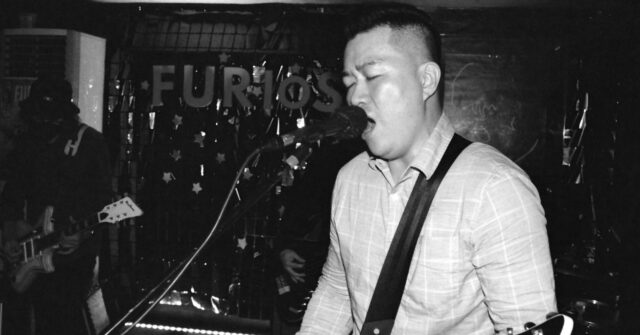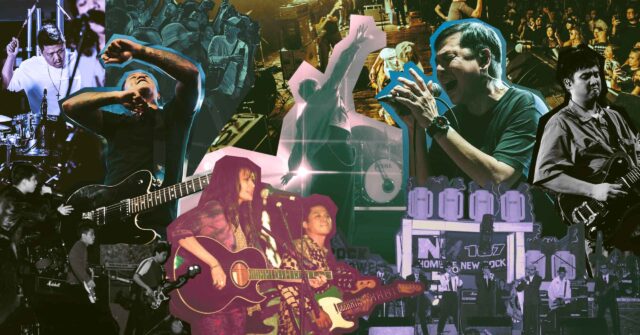In the 1960s, on an island just south of Cuba, a soon-to-be worldwide genre was taking its roots in the country. That genre was Jamaican reggae — a direct evolution of ska and rocksteady. The two genres were heavily influenced by the sounds of Caribbean music, such as calypso and other numerous influences like American blues, jazz, brass sounds, and doo-wop.
Despite being closely related to each other, the three genres have different characteristics. Ska music is mostly upbeat, with prominent brass and horn sections. Reggae and rocksteady have slower tempos, with the instruments playing “offbeat” or in reggae terms, a “one-drop” beat. Reggae music typically has sociopolitical undertones in their lyrics. In comparison, rocksteady incorporates more elements of American soul music, with dominant bass lines and more R&B-style vocal styles.
While the genre was introduced to the Philippines around the late 1960s, it wasn’t until around the ’70s and ’80s where Filipinos started making reggae music. The first wave of reggae bands in the Philippines was born, like the Manila-based acts Cocojam and Tropical Depression
Reggae really made its mark in the ’90s, with the genre especially taking hold in the Visayas and Mindanao regions in the south of the Philippines. Cities like Cebu and Dumaguete became hubs for reggae. Today, reggae bands continue to prop up and prosper in places like Cagayan de Oro, Davao, General Santos, Bukidnon, Bohol, and Bacolod to name a few; areas primarily in Visayas and Mindanao.
However, it’s not just the number of bands that make the genre prominent in these places. Reggae and by extent Jamaican culture has intertwined itself in the cultures of these areas, with different concerts, festivals, and even organizations dedicated to the reggae culture.
With an influence spanning decades, how did reggae take such a hold in the south? What does the future of the genre look like now?
Party People, You’re In TV
Over time, Cebu has been dubbed the “Reggae Capital of the Philippines.” In the province, many reggae fans and musicians were exposed to reggae in universities like UP Cebu and the University of San Carlos. That was the case for current Junior Kilat vocalist Budoy Marabiles. Marabiles first found out about reggae through his professors at UP Cebu’s Fine Arts Department. In the late ’80s to ’90s, reggae music was primarily distributed through vinyl records, which were on the pricier side of things. Fine Arts professors like Javy Villacin would record cassette tapes from his vinyls and share them with his students or people in the department.
“Sa una wala pa’y access sa mga reggae…bisag mga tapes, gamay ra naa. Pero sila, naa na sila — ang usual, mga Bob Marley, UB40…mga early ’80s, late ’90s na banda na sikat sa gawas (At the time, no one had access to reggae…even [cassette] tapes were hard to come by. But [the professors], they had — the usual [artists], like Bob Marley, UB40…the bands in the early ’80s, late ’90s that were popular worldwide),” Marabiles says.
Around 1989 or the early ’90s, Marabiles joined his first reggae band as a percussionist with some of classmates in Fine Arts. That got the ball rolling — not just for Marabiles, but for the reggae scene in Cebu as a whole.
Fine Arts students from the University of San Carlos – Talamban Campus formed the Jah People Society, and together with fellow reggae fans in the city, they started organizing their own Bob Marley Day on Marley’s birthday, February 6.
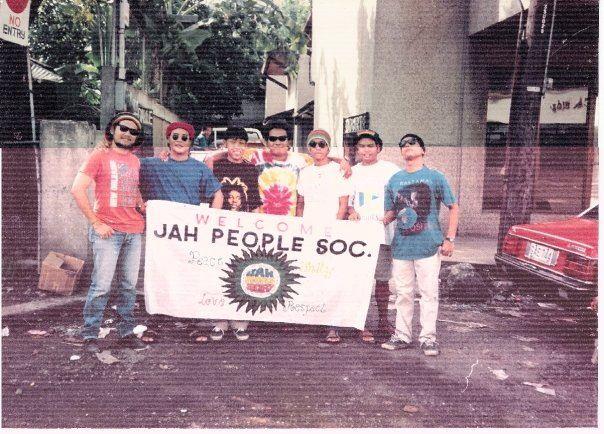
Jah People Society at the University of San Carlos
GK Gonzalez — band leader of Selah Dub Warriors, an organizer of the Bob Marley Festivals, as well as a radio jockey — hosted a radio program where he played reggae on local stations. The program was originally focused on playing hip-hop, but when Gonzalez came back from the United States, he started playing reggae. Gonzalez’s program made its way to different radio stations like Z106 and Y101.
It was in the mid-’90s that Cebuano reggae was in full force. From 1997 to 1998, Junior Kilat and other bands like Urbal, Who’s Next, and Purplepaka recorded a compilation of reggae songs that introduced the genre to an even bigger audience. While Gonzalez initially got some flak from his hip-hop listeners for playing reggae, it just needed some time before hip-hop and reggae would eventually fuse to become what is now known as dancehall.
“Exciting sa ’90s kay diha na ga-collab ang lain-laing genres (It was exciting in the ’90s because that’s when different genres would start collaborating),” Marabiles shares.
The rise of reggae
In the late ’90s, the respect and clamor for reggae was potent. The aforementioned Bob Marley Day celebrations consistently drew crowds of people, even in small venues like the now-defunct Kukuk’s Nest and Artist Dais. The gigs became bigger and bigger until the Harambe Society (an offshoot of Jah People Society) eventually organized the Bob Marley Festival.
The Bob Marley Festival was held annually in different places around Cebu City — Baseline (a wide open space that is now an apartment complex), The Village (which is now IT Park, a central business district developed by Ayala Land), and more. They invited some of the most notable reggae bands from the country like Put3ska, Tropical Depression, Hemp Republic, and the like.
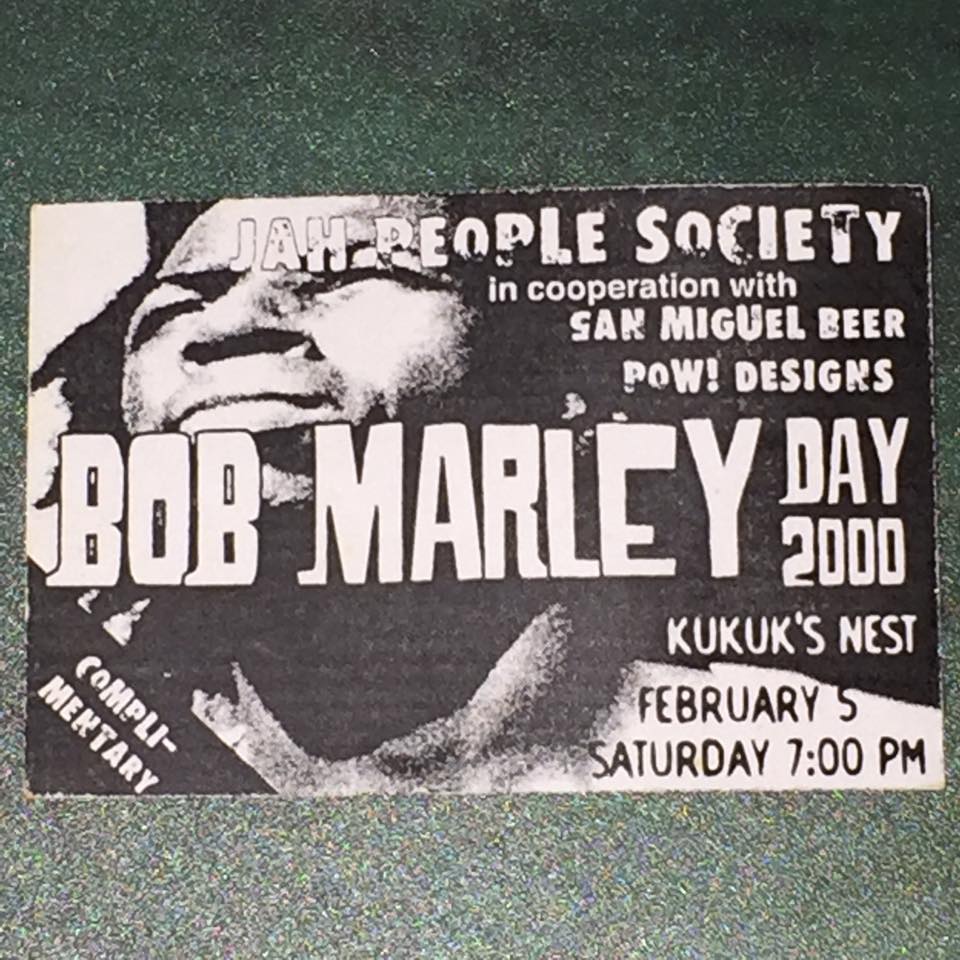
Jah People Society
Cebu’s reggae community all came together to stage the festivals — Ian Sekong, known for his drum work in rock band Powerspoonz — was running a sound system business, and he offered to sponsor the sound gear for the festival’s early iterations. Marabiles admits that as organizers, they weren’t the most business-minded individuals. They struggled with making the festival sustainable — citing instances where sponsors backed out because they weren’t under contract.
The festival eventually got so big to the point that Marabiles shared that Tuff Gong — a brand of the Marley family that’s used for a number of their business — issued a cease and desist letter to the festival organizers regarding the use of the name Bob Marley. As a result, the festival rebranded itself to the Cebu Reggae Festival in 2009.
It turned out to be a blessing in disguise, he shares, because the feasibility of staging it on Bob Marley Day (February 6) presented some challenges regarding logistics. The date was too close to the Sinulog Festival, which is held every third Sunday of January. Branding the festival as the Cebu Reggae Festival gave the organizers allowance to be more flexible with the dates and to get more sponsors. They started holding the festival in the summer season, like in March or April.
The Cebu Reggae Festival isn’t the only music event for the genre. In 2017, Jayson “Angkol Onyok” Ugbaniel of trailblazing Mindanawon reggae band Kuerdas, organized the first ever Mindanao Roots Reggae Festival.

Mindanao Roots Reggae Festival
“This event was born 7 years ago with the ultimate aim of gathering budding and core reggae artists in camaraderie so they can perform their original music on stage,” shares Onyok. “They carry with them the pride of representing their own towns, municipalities, and cities.”
Reggae in Mindanao developed a little bit later than in Cebu, however, Onyok says that the reggae community in the region is alive and well. Whether its in the densely populated areas or in far-flung places, events like reggae and unity jams are organized by local reggae artists. He attributes the rise of reggae to social media.
“Here in Mindanao, reggae scenes are active in Davao, Gensan, Bukidnon, and many more areas. Social media has a played a pivotal role in spreading the message of reggae music, the positive vibes, and the influence of reggae artists who got famous in their own crafts,” he shares. “Reggae bands and lovers multiplied in numbers, which was primarily attributed to the advent of social media.”
This was very different compared to when Kuerdas first started. The band’s journey started in 2002 when Onyok was introduced to Bob Marley while in Boracay. He came from a theatre background and was already a fan of world music, so when he was stationed in Boracay for a month-long show, he brought his newfound love for reggae back to his hometown of General Santos City.
“I decided to put up a reggae band in 2003, performed only pure reggae and there was no turning back since. Kuerdas was able to slowly introduce the music in the city and its neighboring towns in the entire region,” he says. In the early 2000s, reggae was barely recognized or well-known in Mindanao. While in Cebu, Gonzalez had a radio program that played reggae music on the airwaves, it was not the same in Mindanao. Onyok goes on to say that reggae music was rarely on the CDs sold there, and people used to resort to downloading music from iMesh so that they could burn it onto their own records.
He even cited that Kuerdas faced some forms of discrimination while they would perform around their area. “Mura ug gika minusan nila ang music kay easy ra daw kaayo… pati ang porma sab or pananamit, even ang hitsura like kadtung mga naka dreads, yagit daw tanawun, and balik-balik ra daw kuno ang tono sa reggae (They kind of made fun of the music because they said it was ‘too easy’ [and repetitive]…even with the way we dressed, or hairstyles like dreads, they said that we looked messy.)”
Today, the respect and popularity of reggae has completely turned around. Kuerdas was nominated twice for the category of the Best Mindanao Music in Ragga at the 2008 Mindanao Music Awards (Muzika del Sur). The organizing group for the Mindanao Roots Reggae Festival has continuously grown in numbers, with fellow artists and advisers joining the team to continue improving the operations of the festival. Every year, they gather more or less 15 reggae bands from all over the country, and Onyok hopes that they can bring in international reggae artists soon.
One Love
The reggae scene of the ’80s, ’90s, and 2000s set the groundwork for many musicians and music scenes even beyond reggae and its adjacent genres. Marabiles recounts that members of rock bands like Powerspoonz and Urbandub came from the reggae, ska, and rocksteady scenes before establishing their careers in rock.
In Visayas and Mindanao, different styles of reggae continue to flourish in different places. There are bands inspired by the Cali Roots (California Roots) and Jawaiian (a style of reggae that originated in Hawaii and merges Caribbean and Jamaican sounds), as well as reggae roots (a style of reggae that incorporates ethnic, world music elements), reggae pop that uses indigenous instruments in Mindanao, and more.
“Basta akoa maingun kay creative sab pud kaayo dinhi, kumbaga wala’y kopyahay, kung naa na ang isa ing ato ang style, kailangan palahi gamay (For me, I can say that reggae styles in Mindanao are creative, in other words, no one’s copying each other, and if there’s someone that has a similar style, there needs to be some difference, somehow),” Onyok says with a laugh.
There are also bands in both regions that use English in writing their songs. Marabiles’ theory is that the use of English and the more pop-leaning instrumentals originates from how even before, UB40 (an English reggae band) admittedly rose to fame in the Philippines before Bob Marley and The Wailers did. That’s how Marabiles first started out — emulating Jamaican artists, where he would exchange the use of Jamaican Patois with Bisaya instead. Jamaican reggae served as a template. After research, he discovered where he could use the Bisaya language even more, as well as how to phrase words over the beats and rhythms.
Decades after the genre first took hold in the country, its presence and popularity still remains in the Visayas and Mindanao regions. Bands like Jayson In Town from Bukidnon, Nairud Sa Wabad from Davao, Igoroots and Wilfreedo in Dumaguete City, and more continue to prove how reggae is not just a genre — it’s a way of life, a community.
